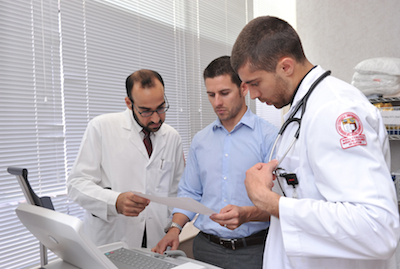Med Students Venture into the Upper Limits of Health
April, 2011

From left to right: Mohammed Al-Hijji, Dr. Mathew Wilson, sports
cardiology specialist at Aspetar, and Mohammed Ali Babi explore
the results of an athelete's electrocardiograph.
Through WCMC-Q’s partnership with Aspetar Orthopaedic and Sports Medicine Hospital, medical students have a unique opportunity to experience rounds at a world-class sports facility. As they drive across Doha to the pristine, sunlit building, they cross the divide between treating illness and exploring the potential of the human body.
“I think if your society is going to embrace a lifestyle where sports is a key, nutrition is a key and wellness is a key, then you need physicians to be well informed and educated in these respects,” said Aspetar’s director general Dr. Mohammed G.A. Al-Maadheed. “And I think this partnership between our organization and WCMC-Q can really produce these kinds of physicians.”
The first sports medicine facility in the region, Aspetar incorporates the latest technology, including rooms that can be set at pressures to simulate altitude changes, and treadmills that reduce the gravitational pull on an athlete as they run. In 2008, Aspetar was accredited as a Federation Internationale de Football Association, FIFA, medical center of excellence.
“The professionals at Aspetar take athletes and help them optimize their condition,” said Amer Homsi, a fourth-year medical student. “Seeing this happen made us appreciate all the tiny details that go into having what we would call a model of physical fitness.”
Aspetar’s nearly 500 staff members—including sports physicians, orthopaedic surgeons, physiotherapists, psychologists, podiatrists, dietitians, radiologists, dentists and internal medicine practitioners—hail from about 50 countries. They work with elite athletes as well as members of the community in the realms of sports medicine, rehabilitation, research, and community health screenings and programs.
Medical students spend five days out of their primary care clerkships at Aspetar, visiting various units each morning and attending lectures in the afternoons. They learn through this brief time there that the sports mentality is contagious—that doctors benefit from working closely together with each other and with the patient, as a team.
“You have to understand that you need to approach anything in this world as a team, you should know your limitation of knowledge,” said Dr. Al-Maadheed. “You could be a leader of a team but that does not mean that you know all the answers.”
“The physical therapist is probably the best opportunity for students to learn different skills they will need in this area,” added Bruce Hamilton, M.D., chief of sports medicine at Aspetar. “Because they deal directly with the patients for long periods of time—they think a different way, they talk a different way and this opens students to a different approach.”
Many students say that the experience at Aspetar shed new light on what sports medicine is—beyond running onto a playing field and applying ice to a player’s injury—and how it could contribute to their practice, no matter what their specialty.
As he sets his sights on internal medicine and a cardiology fellowship, fourth-year medical student Mohammed Al-Hijji said his experience at Aspetar provided new insights on heart health that will contribute to his perspective. “I learned how cardiology applies to sports medicine, including hands-on practice with valuable screening techniques,” he said. “Working at Aspetar has been a great opportunity at a state-of-the-art hospital.”
“We try to engage the students as much as possible in showing them the broadest spectrum,” said Dr. Hamilton. “From trying to manage the athlete with the common cold and minimize their time to play right through to diagnosing a complex knee injury. In terms of managing an injury, we want the physicians to realize that it’s not about putting the situation to rest, it’s about having options for best outcomes and picking and choosing ways to approach the condition.”
Homsi said he was glad to have visited Aspetar after all of his other rotations so that he could see the specialties in a more integrated way. He also said the experience made him want to live a healthier life, a decision that will doubtless affect approach to patients.
“Experiencing the world of sports medicine gives students the idea that not only are you removing a disease but you are also promoting a much higher level of physical, mental and social living,” Dr. Al-Maadheed said.
By Emily Alp
